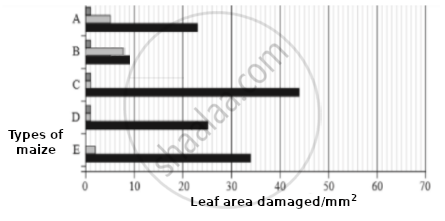Advertisements
Advertisements
प्रश्न
What are biofertilizers? Describe their role in agriculture. Why are they preferred to chemical fertilizers?
उत्तर
Biofertilisers are the living organisms that promote the growth of plants by replenishing the nutrients in the soil. These include bacteria, fungi and cyanobacteria.
Role of biofertilisers in agriculture
-
Some biofertilisers such as Rhizobuim bacteria live in symbiotic association with plants. They live within the root nodules of leguminous plants. These bacteria fix atmospheric nitrogen and enrich the nitrogen content of soil.
-
Fungi such as Glomus also form symbiotic associations with plants (mycorrhiza) by absorbing phosphorus and passing it to plants.
- Cyanobacteria such as Nostoc and Anabaena also fix atmospheric nitrogen and act as biofertilisers, especially in paddy fields.
Biofertilisers are preferred over chemical fertilisers because of the following reasons:
- Biofertilisers are eco-friendly, while chemical fertilisers cause soil pollution in the long run.
- Biofertilisers contain living organisms, while certain chemical fertilisers have high acid content and might also contain heavy metals that can negatively affect soil ecology.
- Biofertilisers are a natural way of improving soil fertility.
APPEARS IN
संबंधित प्रश्न
What is the major advantage of producing plants by micropropagation?
what is golden rice.
How has the use of Agrobacterium as vectors helped in controlling Meloidegyne incognitia infestation in tobacco plants? Explain in correct sequence.
Answer the following question.
Write the desirable characters a farmer looks for in his sugarcane crop.
Maize grain is a fruit known as ______.
Which one of the followmg bacterium is used for the production of transgenic plants?
Bt toxin obtained from ______.
Golden Rice:
A. GM rice
B. Rich in Vit A
C. Prevents blindness
D. Bruise resistant
Insects in the Lepidopteran group lay eggs on maize crops. The larvae on hatching feed on maize leaf and tender cob. In order to arrest the spread of three such Lepidopteran pests, Bt maize crops were introduced in an experimental field.
A study was carried out to see which of the three species of lepidopteran pests was most susceptible to Bt genes and its product.
The lepidopteran pests were allowed to feed on the same Bt-maize crops grown on 5 fields (A-E).
The graph below shows the leaf area damaged by these three pests after feeding on maize leaves for five days.

Key for lepidopteran insect pest species
 |
Species I |
 |
Species II |
 |
Species III |
Insect gut pH was recorded as 10, 8 and 6 respectively for Species I, II and III respectively.
(a) Evaluate the efficacy of the Bt crop on the feeding habits of the three species of stem borer and suggest which species is least susceptible to Bt toxin.
(b) Which species is most susceptible to Bt-maize, and explain why?
(c) Using the given information, suggest why a similar effect was not seen in the three insect species.
How has man exploited cry proteins to his benefit?
